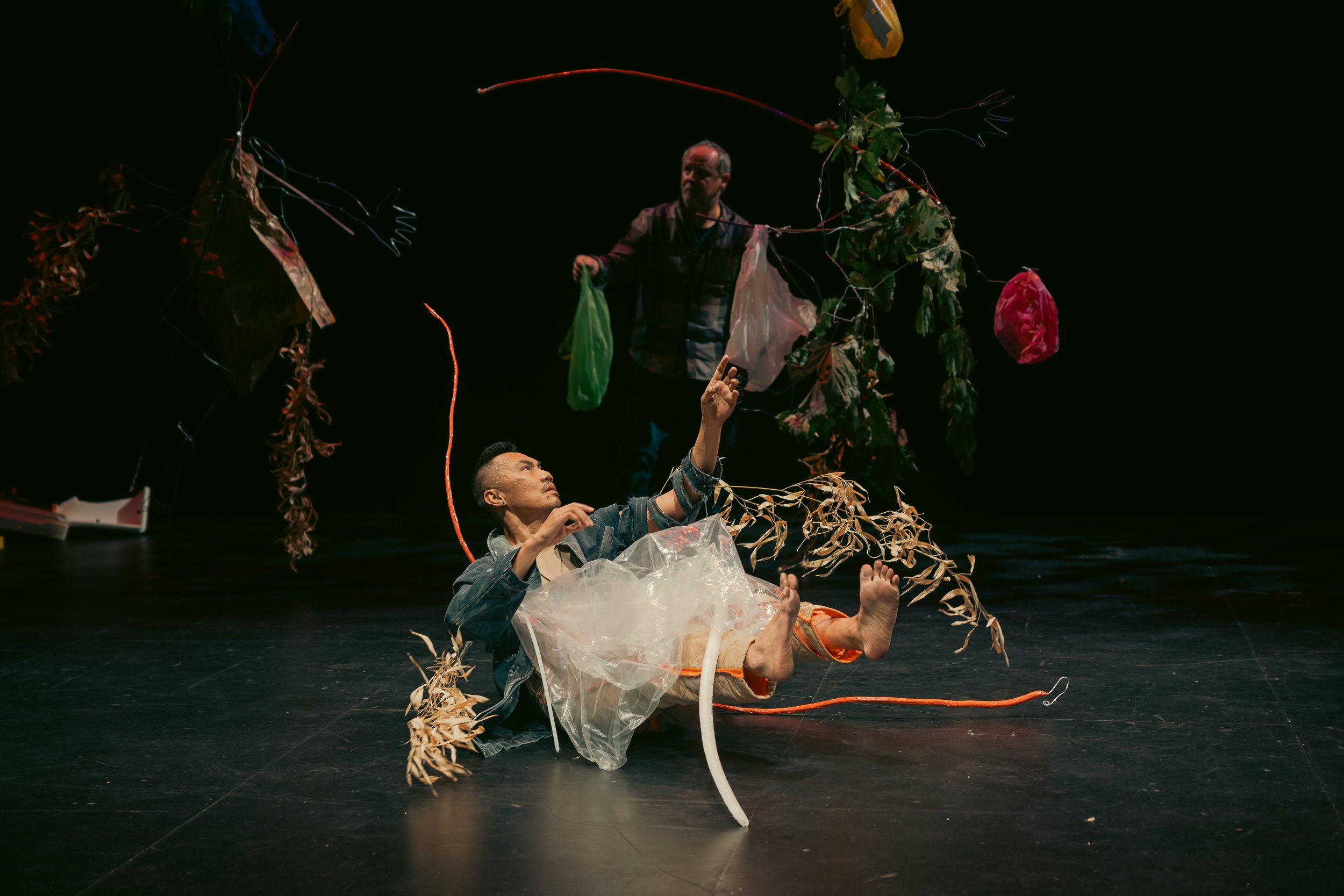Dance review: Buried beneath a mound of trash in Accumulation, Alvin Erasga Tolentino embodies climate anxiety
Emmanuel Mailly’s live score and Marc Gerenton’s sculpture work help craft an utterly creative picture of heartbreak and distress
Accumulation. Photo by Yasuhiro Okada
Co.ERASGA presents Alvin Erasga Tolentino’s Accumulation at Performance Works on Granville Island to November 11
IF YOU WALKED into the theatre midway through Co.ERASGA’s Accumulation, you might not even notice dancer Alvin Erasga Tolentino onstage.
Instead, you’d see a mound of trash—heaving, shifting, shuddering—beneath which Tolentino is writhing, a being of nature overtaken by an accumulation of junk. It’s a sight that weighs heavy on the heart.
Though Accumulation is in essence a dance piece, French creatives Marc Gerenton and Emmanuel Mailly are integral to its progression. Gerenton, a sculptor and visual artist whose works made from found objects often resemble human figures, turns Tolentino into a moving sculpture throughout the piece. Meanwhile, composer-musician Mailly scores the performance live, crafting an evolving atmosphere of suspense and anxiety.
The stage is set forebodingly at the start of the show. Against the back wall hangs a collage of garbage and natural debris. Crumpled sheets of brown paper, shreds of neon-coloured plastic, and gnarled tree branches float suspended mid-air.
Behind the display of trash sits Gerenton, dressed simply in blue jeans and a plaid shirt. He resembles a spectator, though he pays little mind to Tolentino, who’s outfitted in a tattered black denim jacket and neon-orange-lined work pants. As the piece progresses, Gerenton stands up, plucks bits of debris from the floating backdrop and, one by one, fastens them to Tolentino.
At first Tolentino fights back, scurrying away in panic. But as pieces are loaded on, he weakens into the advances, resigned. Gerenton remains unchanged the more trash he piles onto Tolentino, his expression stony. On a deeper level, his mindlessness is symbolic of the way many humans treat nature: the damage doesn’t affect him personally, and therefore, he is unbothered.
Tolentino’s movements throughout Accumulation, though minimalistic, are captivating. He spends much of the piece on the floor curled into himself. Thrashing around painstakingly, Tolentino pauses to take heaving breaths. He lifts a leg and fans it overhead, letting the weight of a sickled foot drop him into a slow roll over, before retreating into fetal position again.
Accumulation. Photo by Yasuhiro Okada
Mailly’s live soundtrack complements Tolentino’s movements flawlessly. He scores the dance piece akin to the way foley artists craft sound design for films, an endlessly creative concept. John Krasinski’s 2018 horror blockbuster A Quiet Place comes to mind—many of the deliberate noises heard in the film, which is otherwise silent, are created in post-production using everyday objects (in one instance, a sound designer twists and cracks crab legs into a microphone to generate audio of a monster walking). In a similar fashion, Mailly watches Tolentino from a work station next to the audience, using his equipment and a variety of props to create sounds that match his movements. At one point, Mailly crumples a ball of plastic against the microphone, producing a static noise as Tolentino vibrates in shock. Elsewhere, he taps two sticks against each other quickly at first before slowing down, which produces an eerie rattling sound to match a moment of suspense from Tolentino.
Mailly uses his own vocals to produce sounds, too, periodically yowling and screeching (a drawn-out “eeeeeee”), or making deep, reverberating echoes (a low “ohhhmm”), and putting them on loop to fade in and out. He also incorporates noises from nature, from a haunting woodwind bird call to the humming and chittering of insects. There’s even a sound bite pulled from a climate march—“What do we want? Climate justice! When do we want it? Now!” Mailly’s ingenuity adds a complexity to Accumulation that renders it a full sensory experience, goosebumps and all.
Near the end of the piece, Tolentino is at a breaking point. His face contorts in agony, teeth bared, as he chokes out in distress. Meanwhile, Mailly fades in an audio clip from an opera performance, complete with cheery clapping. Suddenly it’s clear that Tolentino is no longer wracked with pain—he’s laughing maniacally. It’s disconcerting, to say the least, and certainly leaves an impression.
By the time the performance nears its close, Tolentino collapses, and all the audience is left with is a still pile of trash. The mounting anxiety of the events we’ve just witnessed lingers. Sadness settles in, a byproduct of feeling utterly helpless to what’s happening.
We stare at the heap for so long as Mailly’s score fades out that it’s almost a shock when Tolentino crawls out meekly from beneath the mound and into the darkness. Tolentino may have a chance at life, but the heap of garbage left behind isn’t going anywhere.















